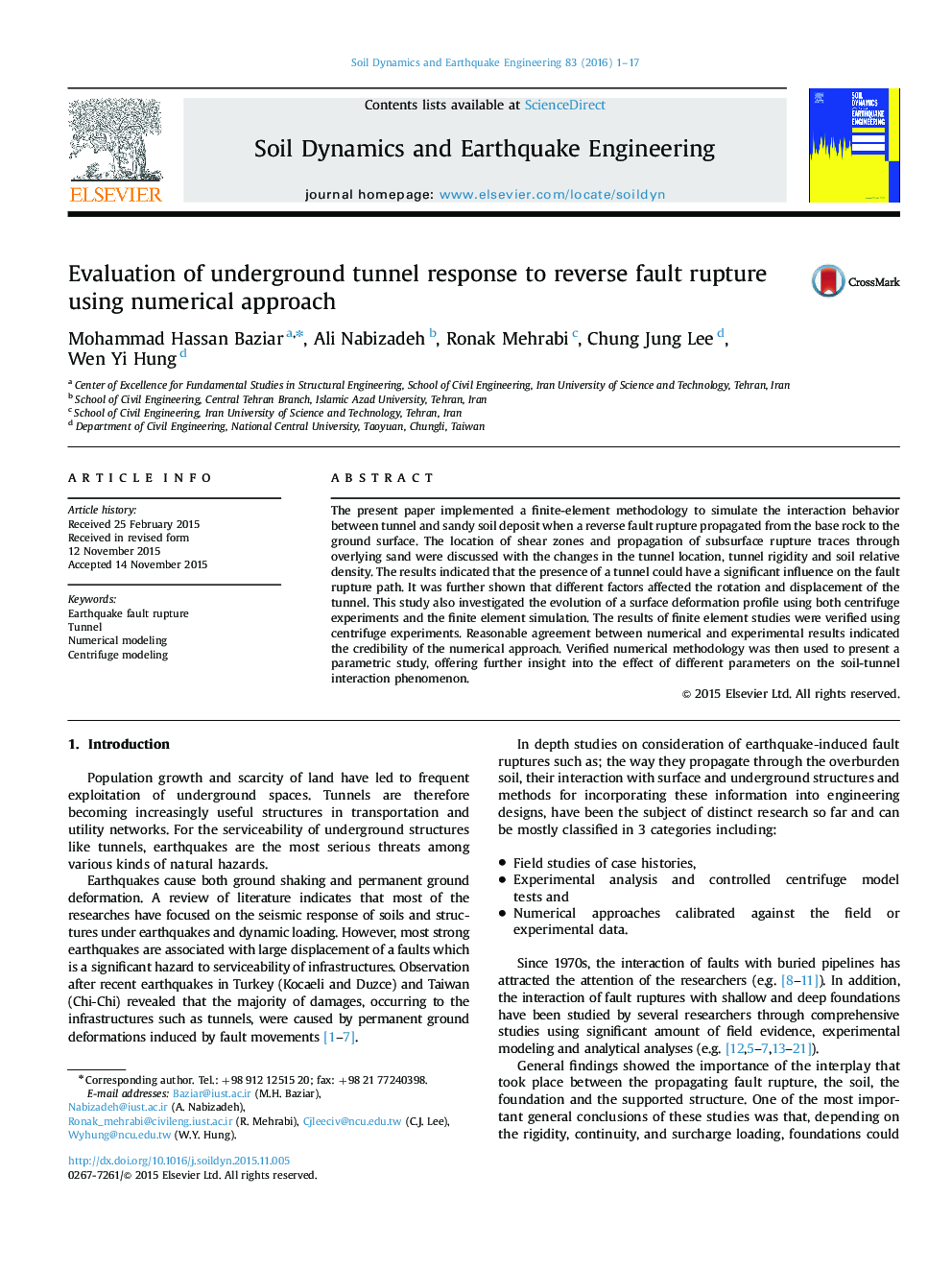| کد مقاله | کد نشریه | سال انتشار | مقاله انگلیسی | نسخه تمام متن |
|---|---|---|---|---|
| 6771466 | 512760 | 2016 | 17 صفحه PDF | دانلود رایگان |
عنوان انگلیسی مقاله ISI
Evaluation of underground tunnel response to reverse fault rupture using numerical approach
ترجمه فارسی عنوان
ارزیابی پاسخ تونل زیرزمینی به پارگی گسل معکوس با استفاده از رویکرد عددی
دانلود مقاله + سفارش ترجمه
دانلود مقاله ISI انگلیسی
رایگان برای ایرانیان
کلمات کلیدی
پارگی گسل زلزله، تونل، مدل سازی عددی، مدل سازی سانتریفیوژ،
ترجمه چکیده
در این مقاله، یک روش متداول-عنصری برای شبیه سازی رفتار تعامل بین تونل و خاک شن و ماسه، زمانی که یک گسل معکوس معکوس از سنگ شسته به سطح زمین پخش می شود. محل زون های برش و انتشار عیوب انقباض زیر زمین از طریق ماسه های پر از آب با تغییرات در محل تونل، سختی تونل و تراکم نسبی خاک مورد بحث قرار گرفت. نتایج نشان داد که حضور یک تونل می تواند تاثیر قابل توجهی در مسیر شکست گسل داشته باشد. بیشتر نشان داده شده است که عوامل مختلف بر چرخش و جابجایی تونل تاثیر می گذارد. این مطالعه همچنین تکامل یک پروفیل تغییر شکل سطح را با استفاده از هر دو آزمایش سانتریفیوژ و شبیه سازی عناصر محدود انجام داد. نتایج مطالعات عناصر محدود با استفاده از آزمایش های سانتریفیوژ تایید شد. توافق منطقی بین نتایج عددی و تجربی نشان دهنده اعتبار رویکرد عددی است. سپس روش شناسی عددی تایید شده برای ارائه یک مطالعه پارامتریک ارائه شد تا بینش بیشتری را در مورد اثر پارامترهای مختلف بر پدیده تعامل بین تونل خاک ایجاد کند.
موضوعات مرتبط
مهندسی و علوم پایه
علوم زمین و سیارات
مهندسی ژئوتکنیک و زمین شناسی مهندسی
چکیده انگلیسی
The present paper implemented a finite-element methodology to simulate the interaction behavior between tunnel and sandy soil deposit when a reverse fault rupture propagated from the base rock to the ground surface. The location of shear zones and propagation of subsurface rupture traces through overlying sand were discussed with the changes in the tunnel location, tunnel rigidity and soil relative density. The results indicated that the presence of a tunnel could have a significant influence on the fault rupture path. It was further shown that different factors affected the rotation and displacement of the tunnel. This study also investigated the evolution of a surface deformation profile using both centrifuge experiments and the finite element simulation. The results of finite element studies were verified using centrifuge experiments. Reasonable agreement between numerical and experimental results indicated the credibility of the numerical approach. Verified numerical methodology was then used to present a parametric study, offering further insight into the effect of different parameters on the soil-tunnel interaction phenomenon.
ناشر
Database: Elsevier - ScienceDirect (ساینس دایرکت)
Journal: Soil Dynamics and Earthquake Engineering - Volume 83, April 2016, Pages 1-17
Journal: Soil Dynamics and Earthquake Engineering - Volume 83, April 2016, Pages 1-17
نویسندگان
Mohammad Hassan Baziar, Ali Nabizadeh, Ronak Mehrabi, Chung Jung Lee, Wen Yi Hung,
